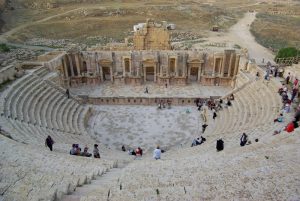Present Status
Astrong earthquake in 749 AD destroyed large parts of Jerash, while subsequent earthquakes along with the wars and turmoil contributed to additional deterioration. Its destruction and ruins remained buried in the soil for hundreds of years until they were discovered by the German Orientalist Ulrich Jasper Seetzen in 1806 to begin excavation and to return life to the city by inhabitants of old villages.
Seven decades later a community of Muslims, Circassians immigrated to Jordan from Caucasus in 1878 after the Ottoman-Russian war settled in Jerash. Also, a large community of people of Syria settled in Jerash at the beginning of the 20th century.
Jerash has developed dramatically in the last century and the growing importance of the tourism industry to the city. Jerash is now the second-most popular tourist attraction in Jordan, closely behind the splendid ruins of Petra. The ruins have been carefully preserved and spared from encroachment, with the modern city sprawling to the west of ancient Jerash’s city walls.
In addition to inhabitants of old villages, Jerash became a destination for many successive waves of foreign migrants. The first wave started during the first half of the twentieth century when the Syrians (Shwam) and the Circassians camped nearby the old ruins. The new immigrants have been welcomed by the local people and settled down in the city. Later, Jerash also witnessed waves of Palestinian refugees who flow to the city in 1948 and 1967.
However, recently the city of Jerash has been expanded to include many of the surrounding villages including Souf, Dairelliat, Thougretasfour, Jaba, Aljbarat and Majar. Other important villages in the governate include: Kitteh, Sakib, Nahlé, Burma, Mustabah, Jubba, Raimoun, Kufr Khall, Balila, and Qafqafa.
Since 1981, the old city of Jerash has hosted the Jerash Festival, a three week long summer program of dance, music, and theatrical performances. The festival is frequently attended by members of the royal family of Jordan and is hailed as one of the largest cultural activities in the region.
Performances of the Roman Army and Chariot Experience (RACE) take place at the hippodrome in Jerash. The show running twice daily features 45 legionaries in full armour in a display of Roman Army drill and battle tactics, 10 gladiators fighting “to the death” and several Roman chariots competing in a classical seven lap race around the ancient hippodrome.
Jerash has an ethnically diverse population, with the majority being Arabs. Circassians and Armenians also exist in a slightly larger percentage compared to other cities in Jordan. The majority of Jerash population is Muslims; however the percentage of Christians (Orthodox and Catholics) in Jerash city is also among the highest in Jordan.
Jerash economy depends largely on the tourists who visit the ancient city. It is also an agricultural city with more than 1.25 million olive trees in Jerash Governorate. However, its proximity (just half an hour ride) from two of the largest cities in Jordan, Amman and Irbid, contributed to slowing down its development, as investments tend to go to the larger cities.
Visiting Jerash
Ancient Jerash remains untouched by the hand of time. Greater Greco-Roman cities in the region such as Gadara and Philadelphia, have vanished almost without trace, but the remoteness of Jerash has saved it from being used as a stone quarry for nearby towns and villages, and it is one of the most complete examples of a provincial Roman city to be seen anywhere.
The site now lies today near a modern highway that links Amman with the northern boundary of the Kingdom towards Syria; the drive takes 40 minutes from Amman. Jerash is certainly worth the visit and will reward visitors with impressive partly rebuilt ruins and excellent views from the top seats of the south theatre. Walking down the colonnaded main street still with over 500 Ionic and Corinthian columns in situ all being over 10m high gives the impression of the magnitude of Gerasa architecture.
Overall the most prominent remains in the Greco-Roman Gerasa include:
- The Corinthian columns

Hydria Virtual Museum
- Hadrian’s Arch
- The hippodrome

Hydria Virtual Museum
- The two large temples (dedicated to Zeus and Artemis)
- The nearly unique oval Forum, which is surrounded by a fine colonnade

Hydria Virtual Museum
- The long colonnaded street or cardo
- Two theatres (the Large South Theatre and smaller North Theatre, right next to the Birktein double pools)

Hydria Virtual Museum
- Two East and the West Bath houses
- Many Byzantine churches
The modern city has a population of ~ 40,000 inhabitants while the wider Municipality (including surrounding villages) is estimated to have a population of 150,000. The modern city planning follows the Turkish settlement, overlaying the eastern part of the ancient city; the archaeological site encompasses the area west of the wadi that visitors see today.